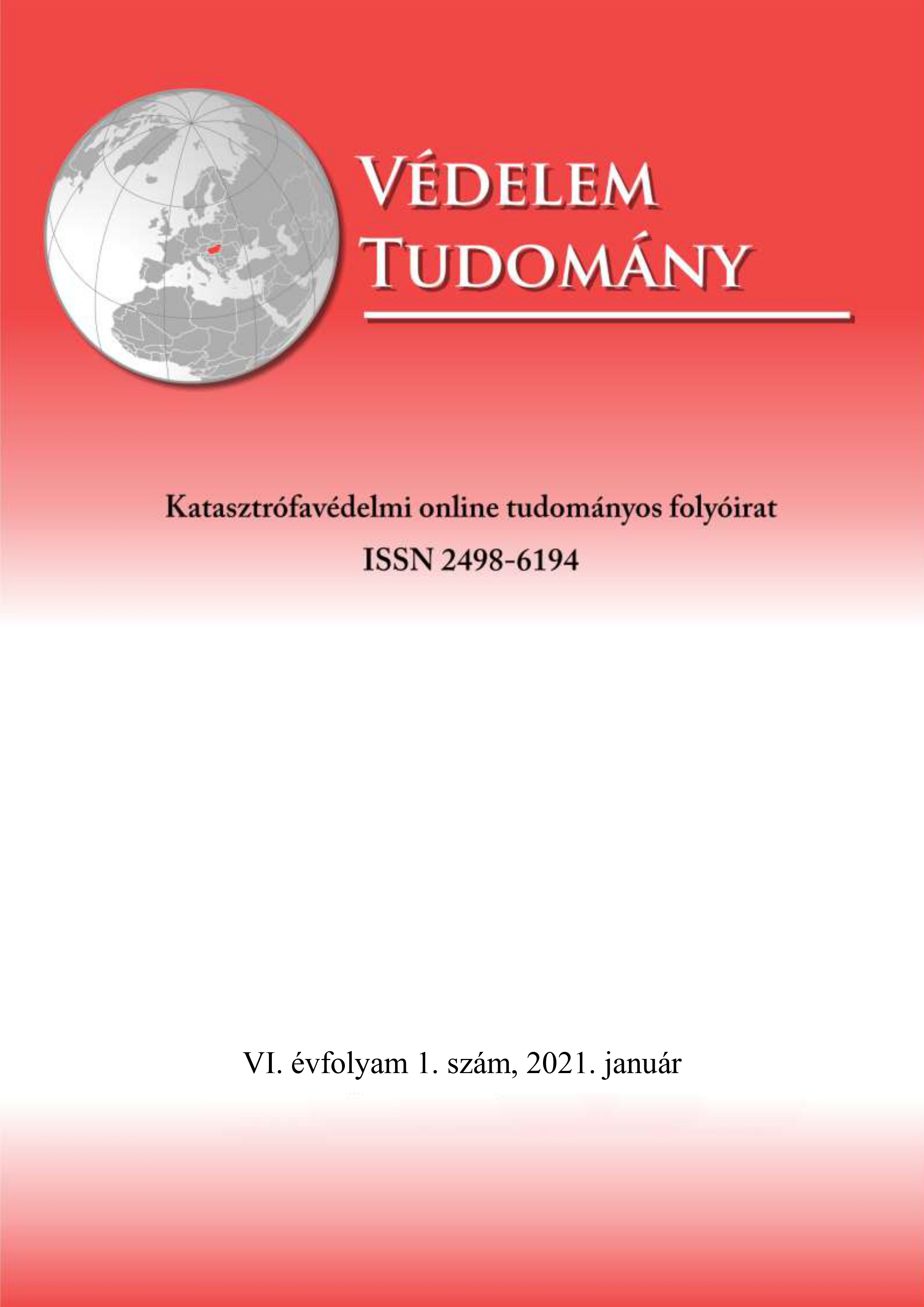A katasztrófákat követő kárenyhítések kríziskommunikációs vonatkozásai
Absztrakt
Jelen tanulmány PhD kutatásommal összefüggésben készült – mely az árvízi katasztrófákat követő kárenyhítések értékelésének módszertani kérdéseit tanulmányozza – és azzal foglalkozik, hogy vizsgálja a korábbi kutatásaimban elemzett társadalmi bizalom kríziskommunikációs kapcsolódási pontjait. A kommunikáció és a média hatásai a közvélemény alakulására vitathatatlanok. Ebből az állításból és a korábbi kutatási tapasztalataimból kiindulva fontosnak tartottam, hogy a katasztrófákat követő kárenyhítéseket koordináló BM Országos Katasztrófavédelmi Főigazgatóság és a vele kapcsolatban levő közszolgálati médiát reprezentáló Magyar Távirati Iroda (MTI) kommunikációs tevékenységének ide vonatkozó, releváns részeit illetékes szakemberekkel való interjú készítéssel (empirikus kutatás) feltárjam. Az általános témafelvezető és feltáró kérdéseken kívül fontos volt, hogy képet kapjak arról, hogy az említett szervezetek vizsgálják-e a kommunikációs tevékenységük társadalmi hatásait, vagyis, hogy a kríziskommunikáció milyen visszacsatolást eredményez a kárenyhítéssel érintett vagy a közvetve érintett lakosság körében. Ebben a cikkben röviden ismertetem a téma jelentősebb szakirodalmait és az említett interjúk összegző eredményeit.
Hivatkozások
Aldrich, D.P. (2012): Building Resilience: Social Capital in Post-disaster Recovery. University of Chicago Press, Chicago, 248 p. (ISBN-13: 978-0226012889)
Ali, Z. S. (2013): Mediamyths and realities in natural disasters. European Journal of Business and Social Sciences. Vol. 2. Iss. 1. pp. 125-133.
Angelusz R. (2000): A láthatóság görbe tükrei. Új mandátum Könyvkiadó, Budapest, 308 p. (ISBN: 963-9336-08-4)
Bene V. (2010): A média szerepe és hatása a lakosság tájékoztatásában. Hadtudományi Szemle. 3. évf. 2.sz. pp. 120-125.
Boda Zs. – Patkós V. (2015): A „politikai kormányzás” a média- és a közpolitikai napirendek tükrében 2010 és 2014 között. Politikatudományi Szemle. XXIV. évf. 4. sz. pp. 68-94.
Chacowry, A. (2016): Public perceptions of living with flood risk from media coverage in the small island developing state of Mauritius. International Journal of Disaster Risk Reduction. 2016. Vol. 19. pp. 303-310.
Cheng, J.W. – Mitomo, H. – Otsuka, T. – Jeo, S. Y. (2016): Cultivation effects of mass and social media on perceptions and behavioural intentions in post-disaster recovery – The case of the 2011 Great East Japan Earthquake. Telematics and Informatics. 2016. Vol. 33 pp. 753-772.
Cheng, J.W. – Mitomo, H. – Otsuka, T. – Jeon, S.Y. (2015): The effects of ICT and mass media in post-disaster recovery – A two model case study of the Great East Japan Earthquake. Telecommunications Policy. Vol. 39. Iss. 6. pp. 515-532.
Committee on Disasters and the Mass Media (CDMM) (1980): Disasters and the Mass Media. National Academy of Sciences, Washington, D.C., 299 p.
Császi L. (1999): Katasztrófák média-reprezentációja. JEL-KÉP. 1999. évi 3. sz. pp. 1-14.
Csernyikné P. Á. (2007): Katasztrófapszichológia. Rendőrtiszti Főiskola nyomdája, Budapest, 108 p.
Dobson T. (2002): Veszélyhelyzet kommunikáció, pánikkezelés. Szakdolgozat. Vitéz János Római Katolikus Tanítóképző Főiskola, Kommunikáció Szak, Esztergom, 35 p.
Dobson T. (2003): A magyarországi ár- és belvízi katasztrófaveszélyes helyzetek kommunikációs stratégiájának tapasztalatai. http://www2.vizugy.hu/vir/vizugy.nsf/7efd30c51842ae20c1256a8900382968/1100b95e44f00
b8dc1256e5b004d6344?OpenDocument, letöltés dátuma: 2017. április 4.
Duhe, S. F. (2008): Communicating katrina: a resilient media in ternational. International Journal of Mass Emergencies and Disasters. Vol. 26. Iss. 2. pp. 112-127.
Fathi S. (2014): How to Create an Effective Crisi Communication Plan before Disaster Strikes. Ragan Breakthrough Strategies for Corporate Communicators Conference. Dallas, Texas, USA, 12th November 2014. https://www.slideshare.net/Sfathi/sandra-fathi-how-tocreat-an-effective-crisis-communications-plan-ragan-nov-12-2014-4x3, letöltés dátuma: 2017. április 4.
Fisher, H. (1998): Response to Disaster. University Press of America, Lanham, 258 p. (ISBN-10: 0761841172)
Ghavamnia, M. – Dastjerdi, H. V. (2013): Contrasts among Journalists in reporting an Event. Akdeniz Language Studies Conference 2012. Socialand Behavioral Sciences. 2013. Vol. 70. pp. 447-457.
Gonzenbach, W. (1996): The Media, the President and Public Opinion. Lawrence, Mahwah, New Jersey, 117 p. (ISBN: 0805816895, 9780805816891)
Graber, D. (1984): Processing the News: How People Tame the Information Tide. Longman. New York, 300 p. (ISBN-13: 978-0801300479)
Hawkins, R. – Maurer, K. (2010): Bonding, bridging and linking: how social capital operated in new Orleans following hurricane katrina. The British Journal of Social Work. 2010.Vol. 40. pp. 1777-1793.
Houston, J. B. – Pfefferbaum, B. J. – Rosenholtz, C. E. (2012): Disaster news: framing and frame changing incoverage of major U.S.natural disasters, 2000–2010. Journalism & Mass Communication Quarterly. 2012. Vol. 4. pp. 606-623.
Mayunga, J. S. (2007): Understanding and applying the concept of community disaster resilience: A capital-based approach. A draft working paper prepared for the summer academy for social vulnerability and resilience building, 22-28 July 2007, Munich, Germany, 16 p. https://www.u-
cursos.cl/usuario/3b514b53bcb4025aaf9a6781047e4a66/mi_blog/r/11._Joseph_S._Mayunga.pdf, letöltés dátuma: 2020. április 3.
Nimmo, D. – Combs, J. (1985): Nightly Horrors: Crisis Coverage in Television Network News. University of Tennessee Press, Knoxville, 216 p. (ISBN: 0-870-49-443-0)
Puente, S. – Pellegrini, S. – Grassau, D. (2013): How to measure professional journalistic standards in television news coverage of disasters 27-Fearthquakein Chile. International Journal of Communication. 2013. Vol. 7. pp. 1896-1911.
Putnam, R. D. (1993): Making democracy work: Civic traditions in modern Italy. Princeton University Press, Princeton, 258 p. (ISBN-13: 978-0691037387)
Putnam, R. D. (2000): Bowling alone: The collapse and revival of American community. Simon & Schuster, New York, 544 p. (ISBN-13: 978-0743203043)
Restás Á. (2012): A 2010-es észak-magyarországi árvizek katasztrófa-elhárítási tevékenységeinek néhány logisztikai és menedzsment tapasztalata. Katonai Logisztika. 2012. évi 4. sz. pp. 43-56.
Shaw, R. (2014): Community-based recovery and development in Tohoku, Japan. pp. 391-410. In: Disaster and Development Examining Global Issues and Cases. (Eds. Kapucu, N. – Liou, K.T.) Springer International Publishing, Switzerland, 469 p. ISBN 978-3-319-04468-2
Todd, D., – Todd, H. (2011): Natural disaster response – Lessons from evaluations of the World Bank and others. Independent Evaluation Group, Communications, Learning, and Strategy, The World Bank, Washington, DC, 33 p. (ISBN-13: 978-1-60244-202-3)
Vasterman, P. – Yzermans, C. J. – Dirkzwager, A. J. E. (2005): The role of the media and media hypes in the aftermath of disasters. Epidemiologic Reviews. 2005. Vol. 27. pp. 107-114.
Walters, L. – Wilkins, L. – Walters, T. (1989): Bad Tidings: Communication and Catastrophe. Lawrence Erlbaum, Hillsdale, 214 p. (ISBN: 0-89859-951-2)
Wenger, D. – Friedman, B. (1986): Local and national media coverage of disaster: a content analysis of printmedia's treatment of disaster myths. International Journal of Mass Emergencies and Disasters. Vol. 4 Iss. 3. pp. 27-50.




